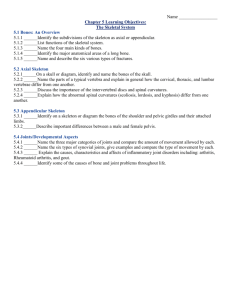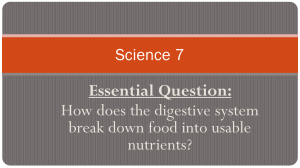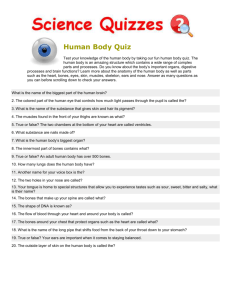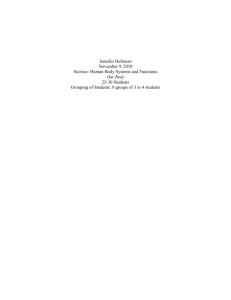Skin, Skeleton, Nervous System
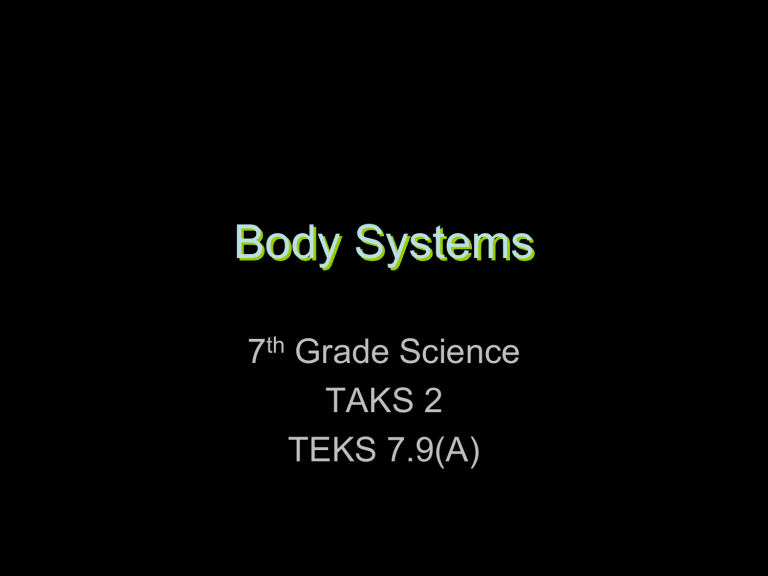
Body Systems
7 th Grade Science
TAKS 2
TEKS 7.9(A)
TAKS Objective 2
The student will demonstrate an understanding of living systems and the environment – Interdependence occurs among living systems
TEKS
• TEKS 7.9 (A) identify the systems of the human organism and describe their functions.
Student Prior Knowledge
• TEKS 6.10 (C) identify how structure complements function at different levels of organization including organ and organ systems.
Background
Human Body Team
Parts and Their Function
Integumentary System
Skin, Hair and Nails
• I cover and protect every place on the body!
• I am the first line of defense against invasion and injury.
• I retain body heat yet, have pores to release excess heat and wastes.
• I retain moisture and your body is almost 80% water!
Skeletal System
• Without me, you’d have no shape or structure…you’d be a blob.
• I make you able to move!
• I make your red blood cells that carry oxygen to all the cells.
• I protect the precious brain, heart and spinal cord.
Muscular System
• The heart is made of cardiac muscle.
• The internal organs are made of smooth muscle.
• Without the skeletal muscles the bones couldn’t move.
Respiratory System
• I bring in the oxygen that is carried on the red blood cells…without me you’d have no oxygen to carry!
• I carry the CO2 (waste gas) out of the body.
• The circulatory system needs me for gas exchange.
• The muscles need oxygen to move.
• The brain needs my oxygen to think.
Circulatory System
• I carry oxygen and nutrients to every cell in the body!
• I am the heart, the veins, the arteries, capillaries and blood.
• I transport the white blood cells to all the infections and injuries.
• Without me, the oxygen and the CO2 in the body couldn’t reach the cells or lungs.
Nervous System
I tell everything what to do. I tell the heart when to beat, the body when to move, the digestive system to add enzymes.
I am the leader.
Digestive/Excretory System
• Without my system, the body would not be able to obtain energy and nutrients.
• I break down all the food stuffed in my mouth into usable nutrients and expel the wastes.
Reproduction System
• Without me, there would be not be any systems.
• I am how the species continues.
Body Systems
Skin Deep
ENGAGE
• Divide into four groups.
• Using a pencil and piece of paper compete to list as many ORGANS of the body as you can in ONE minute.
1.
What characteristics do all of these organs share?
2.
How do they differ?
3.
What are organs composed of?
4.
What would happen if you were missing an organ?
5.
(If necessary) Would you consider skin to be an organ? Why or why not?
6.
What functions does your skin serve?
7.
What are some examples of organ systems?
EXPLORE
• Have students work independently or as a class through the MD
Anderson Project
SAFETY CD/
Curriculum Lesson
One – Layers of the
Skin and Lesson One
Terminology (drag and drop).
EXPLAIN
ELABORATE
• Elaboration 1
Interactive Tutorial on Burns
Burn Tutorial
Have students participate in the interactive tutorial from the national institute of health reviewing the skin and researching different degrees of burns and the layers of skin that they affect.
Burn Flyer
• Elaboration 2
Informational Brochure on Burns
.
Have students participate in research of different degrees of burns and the layers of skin that they affect.
EVALUATE
Label a diagram of the skin and list 3 functions of the skin.
No Bones About It!!
ENGAGE
Show short clip from The Blob .
Have Scary Skeleton song and animation playing when student enter the room.
http://www.learnenglish.org.uk/kids/songs/skeleton.html
Then read:
Dem Bones by Bob Barner. Publisher: Chronicle Books.
EXPLORE
1. Deboned
2. Q-Tip Skeleton
EXPLAIN
What are the five main function of the skeleton?
1. provide structure and support for body
2. protect internal organs
3. make blood cells
4. store minerals
5. attachment for muscles for movement
ELABORATE
• Weird Proportions
• Bone Up Your Knowledge
Computer Lab
Questions
1. List three functions of our skeletal system.
2. What are two things that our skeletal system stores?
3. How many bones does the average mature adult have in their body?
4. What are three things that our bones need to stay healthy?
5. List 5 different bones that are found in our body.
EVALUATE
1.
After observing the chicken bone soaked in vinegar and water and participating in a class discussion, the learner will produce a Venn diagram, table or sketch in his/her journal to compare and contrast the bones. A grade of pass/fail will be given.
2.
After observing both models of the bones and participating in a class discussion, the learner will record the differences between hollow and solid bones. A grade of pass/fail will be given.
3.
Using the text, and class notes, the learner will produce a labeled sketch in his/her journal that describes the components of a bone. A grade of pass/fail will be given.
4.
Using the text, information from the website, and class notes, the learner will demonstrate an understanding of the structures and list at least 4 functions of the skeletal system by creating labeled drawings and providing a 100-word summary of the overall function of the skeletal system. A minimum score of 70% on the rubric is required.
5.
After completing the Q-tip skeleton, the learner will identify the following major bones of the body: skull, spine, ribs, pelvis, femur, tibia, fibula, humerus, radius, ulna, phalanges, and collar bone.
Come to Your Senses!
ENGAGE
Show students various optical illusions
Power Point Optical Illusions
EXPLORE
• Create Edible Brain Models
• Neuron Bead Model
• Brain Game
EXPLAIN
Neuron Model
ELABORATE
• Find Your Blind Spot
• Sweet Visions
• Smeller Feller
• 2-Point Discrimination
EVALUATE
Neuro-Jeopardy
Urinary System
ENGAGE
Tell the Urban Legend Story
“Travelers Beware”
EXPLORE
CONSTRUCT THE URINARY SYSTEM
EXPLAIN
Describe to your partner the parts and the pathway of the excretory system.
ELABORATE
Kidney Filtration Simulation Lab
Students will participate in a lab activity that will simulate the overall function of the kidneys.
EVALUATE
1.
Students will construct a model of the urinary system with 100% accuracy. A grade of pass or fail will be given.
Digestive System
ENGAGE
Watch digestive system clip with gold medalist Bonnie Blair from
PBS video Universe Within.
EXPLORE
Digestion Simulation
EXPLAIN
1.
When you cut your “food” what did this represent?
2. What types of nutrients are digested by each structure.
3. For each digestive structure, tell me if the food was digested physically, chemically, or both.
4. In what digestive structure are the most nutrients absorbed?
5. Where does undigested food leave the body?
ELABORATE
• Digestion Website Investigation
• Informational Brochure on Digestive Issues
EVALUATE
1.
After completing the digestion simulation, the student will have produced an identical piece of
“food” with their name on it in the “anus.” A grade of pass/fail will be given for correct procedure during the simulation.
2.
Using the text, class notes, website information and class discussion the learner will produce a labeled sketch in his/her journal that describes the structures and functions of the digestive system. A grade of pass/fail will be given.
3.
Using the text, information from the website, and class notes, the learner will demonstrate an understanding of the structures and functions of the digestive system by creating an informational brochure. A minimum score of 2 on the rubric is required.

